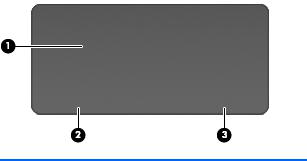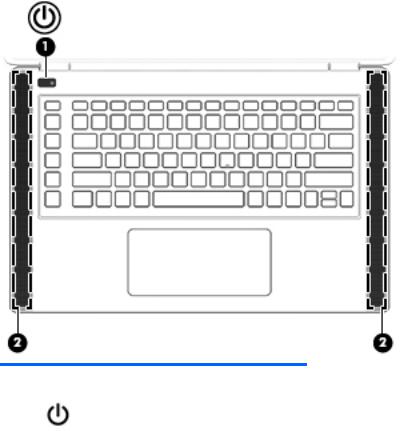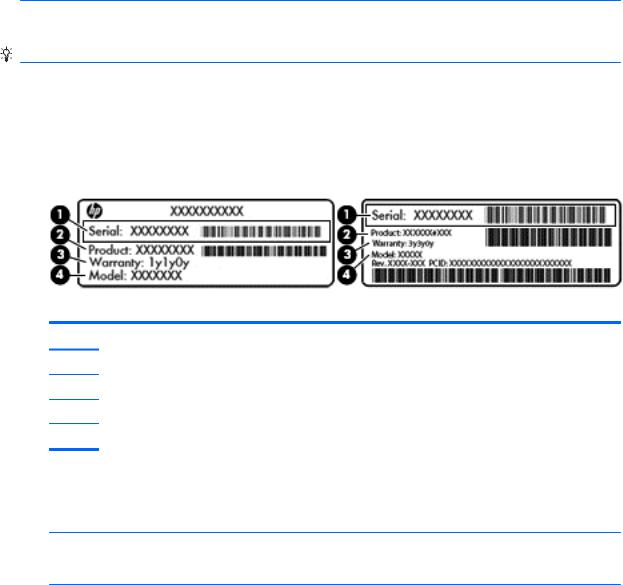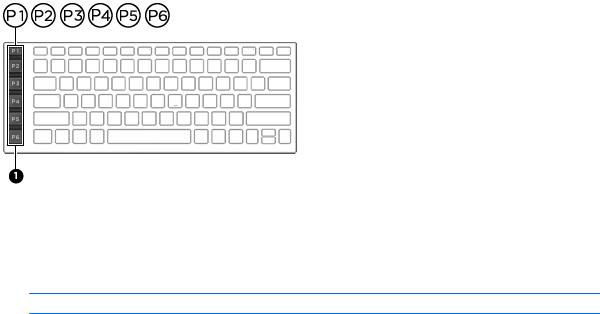HP L9H59UT, L9H60UT User manual
User Guide
© Copyright 2015 Hewlett-Packard
Development Company, L.P.
Bluetooth is a trademark owned by its proprietor and used by Hewlett-Packard Company under license. Intel is a trademark of Intel Corporation in the U.S. and other countries. Microsoft and Windows are U.S. registered trademarks of the Microsoft group of companies.
The information contained herein is subject to change without notice. The only warranties for HP products and services are set forth in the express warranty statements accompanying such products and services. Nothing herein should be construed as constituting an additional warranty. HP shall not be liable for technical or editorial errors or omissions contained herein.
First Edition: March 2015
Document Part Number: 804231-001
Product notice
This guide describes features that are common to most models. Some features may not be available on your computer.
Not all features are available in all editions of Windows. This computer may require upgraded and/or separately purchased hardware, drivers and/or software to take full advantage of Windows functionality. Go to http://www.microsoft.com for details.
To access the latest user guide, go to http://www.hp.com/support, and select your country. Select Drivers & Downloads, and then follow the on-screen instructions.
Software terms
By installing, copying, downloading, or otherwise using any software product preinstalled on this computer, you agree to be bound by the terms of the HP End User License Agreement (EULA). If you do not accept these license terms, your sole remedy is to return the entire unused product (hardware and software) within 14 days for a full refund subject to the refund policy of your seller.
For any further information or to request a full refund of the price of the computer, please contact your seller.

Safety warning notice
 WARNING! To reduce the possibility of heat-related injuries or of overheating the computer, do not place the computer directly on your lap or obstruct the computer air vents. Use the computer only on a hard, flat surface. Do not allow another hard surface, such as an adjoining optional printer, or a soft surface, such as pillows or rugs or clothing, to block airflow. Also, do not allow the AC adapter to come into contact with the skin or a soft surface, such as pillows or rugs or clothing, during operation. The computer and the AC adapter comply with the user-accessible surface temperature limits defined by the International Standard for Safety of Information Technology Equipment (IEC 60950).
WARNING! To reduce the possibility of heat-related injuries or of overheating the computer, do not place the computer directly on your lap or obstruct the computer air vents. Use the computer only on a hard, flat surface. Do not allow another hard surface, such as an adjoining optional printer, or a soft surface, such as pillows or rugs or clothing, to block airflow. Also, do not allow the AC adapter to come into contact with the skin or a soft surface, such as pillows or rugs or clothing, during operation. The computer and the AC adapter comply with the user-accessible surface temperature limits defined by the International Standard for Safety of Information Technology Equipment (IEC 60950).
ENWW |
iii |
iv |
Safety warning notice |
ENWW |

Table of contents
1 Starting right ................................................................................................................................................ |
1 |
Best practices ......................................................................................................................................................... |
1 |
More HP resources ................................................................................................................................................. |
2 |
2 Getting to know your computer ...................................................................................................................... |
3 |
Finding your hardware and software information ................................................................................................ |
3 |
Right side ............................................................................................................................................................... |
4 |
Rear ........................................................................................................................................................................ |
5 |
Display ................................................................................................................................................................... |
6 |
Top ......................................................................................................................................................................... |
7 |
Touchpad ............................................................................................................................................. |
7 |
Lights ................................................................................................................................................... |
8 |
Buttons and speakers ......................................................................................................................... |
9 |
Keys ................................................................................................................................................... |
10 |
Labels ................................................................................................................................................................... |
11 |
3 Customizable keyboard ................................................................................................................................ |
12 |
HP Keyboard Control ........................................................................................................................................... |
12 |
Current settings ................................................................................................................................................... |
13 |
User profiles ........................................................................................................................................................ |
13 |
Programmable keys ............................................................................................................................................ |
14 |
Lighting zones ..................................................................................................................................................... |
15 |
Advanced keyboard settings ............................................................................................................................... |
16 |
Keyboard shortcuts ........................................................................................................................... |
17 |
Disable key assignments .................................................................................................................. |
18 |
4 Connecting to a network .............................................................................................................................. |
19 |
Connecting to a wireless network ....................................................................................................................... |
19 |
Using the wireless controls ............................................................................................................... |
19 |
Using the wireless button ............................................................................................... |
19 |
Using HP Connection Manager (select models only) ..................................................... |
20 |
Using operating system controls ................................................................................... |
20 |
Sharing data and drives and accessing software ............................................................................. |
20 |
Using a WLAN ..................................................................................................................................... |
21 |
Using an Internet service provider ................................................................................. |
21 |
Setting up a WLAN .......................................................................................................... |
22 |
ENWW |
v |
Configuring a wireless router ......................................................................................... |
22 |
Protecting your WLAN ..................................................................................................... |
22 |
Connecting to a WLAN ..................................................................................................... |
23 |
Using Bluetooth wireless devices ..................................................................................................... |
23 |
5 Enjoying entertainment features .................................................................................................................. |
24 |
Multimedia features ............................................................................................................................................ |
24 |
Using the webcam ............................................................................................................................................... |
25 |
Using audio .......................................................................................................................................................... |
26 |
Connecting speakers ......................................................................................................................... |
26 |
Connecting headphones and microphones ...................................................................................... |
26 |
Testing your audio features .............................................................................................................. |
26 |
Using video .......................................................................................................................................................... |
26 |
Connecting video devices by using an HDMI cable ........................................................................... |
27 |
Setting up HDMI audio .................................................................................................... |
27 |
Connecting digital display devices by using a DisplayPort cable ..................................................... |
28 |
Using Intel Wireless Display and Wireless Music (select models only) ............................................ |
29 |
6 Navigating the screen .................................................................................................................................. |
30 |
Using the touchpad and gestures ....................................................................................................................... |
30 |
Scrolling ............................................................................................................................................. |
31 |
2-finger pinch zoom .......................................................................................................................... |
31 |
Rotating ............................................................................................................................................. |
32 |
Flicking .............................................................................................................................................. |
32 |
Using the keyboard and mouse ........................................................................................................................... |
32 |
Using the keys ................................................................................................................................... |
33 |
Using the action keys ...................................................................................................... |
33 |
Using ALT GR key combinations ..................................................................................... |
34 |
7 Using HP Performance Advisor ...................................................................................................................... |
35 |
Managing BIOS with HP Performance Advisor .................................................................................................... |
35 |
8 Managing power .......................................................................................................................................... |
36 |
Initiating Sleep and Hibernation .......................................................................................................................... |
36 |
Manually initiating and exiting Sleep ................................................................................................ |
37 |
Manually initiating and exiting Hibernation (select models only) ................................................... |
37 |
Setting password protection on wakeup .......................................................................................... |
37 |
Using the power meter ........................................................................................................................................ |
38 |
Selecting a power plan ........................................................................................................................................ |
38 |
Running on battery power ................................................................................................................................... |
38 |
vi |
ENWW |
Factory-sealed battery ..................................................................................................................... |
38 |
Finding battery information .............................................................................................................. |
39 |
Conserving battery power ................................................................................................................. |
39 |
Identifying low battery levels ........................................................................................................... |
39 |
Resolving a low battery level ............................................................................................................ |
39 |
Resolving a low battery level when external power is available .................................. |
39 |
Resolving a low battery level when no power source is available ................................ |
39 |
Resolving a low battery level when the computer cannot exit Hibernation ................. |
40 |
Running on external AC power ............................................................................................................................ |
40 |
Troubleshooting power problems .................................................................................................... |
40 |
Refreshing your software content with Intel Smart Connect Technology (select models only) ....................... |
41 |
Shutting down the computer .............................................................................................................................. |
42 |
9 Maintaining your computer .......................................................................................................................... |
43 |
Improving performance ....................................................................................................................................... |
43 |
Handling drives .................................................................................................................................. |
43 |
Using Disk Cleanup ............................................................................................................................ |
43 |
Updating programs and drivers .......................................................................................................................... |
44 |
Cleaning your computer ...................................................................................................................................... |
44 |
Cleaning procedures ......................................................................................................................... |
44 |
Cleaning the display ........................................................................................................ |
44 |
Cleaning the sides or cover ............................................................................................. |
44 |
Cleaning the touchpad, keyboard, or mouse ................................................................. |
45 |
Traveling with or shipping your computer .......................................................................................................... |
45 |
10 Securing your computer and information ..................................................................................................... |
47 |
Locating your security software ......................................................................................................................... |
47 |
Using passwords .................................................................................................................................................. |
47 |
Setting Windows passwords ............................................................................................................. |
48 |
Setting Setup Utility (BIOS) passwords ............................................................................................ |
48 |
Using Internet security software ......................................................................................................................... |
49 |
Using antivirus software ................................................................................................................... |
49 |
Using firewall software ..................................................................................................................... |
49 |
Installing software updates ................................................................................................................................ |
49 |
Installing critical security updates .................................................................................................... |
49 |
Installing HP and third-party software updates .............................................................................. |
50 |
Securing your wireless network .......................................................................................................................... |
50 |
Backing up your software applications and information ................................................................................... |
50 |
ENWW |
vii |
11 Using Setup Utility (BIOS) and HP PC Hardware Diagnostics (UEFI) ................................................................. |
51 |
Starting Setup Utility (BIOS) ................................................................................................................................ |
51 |
Updating the BIOS ................................................................................................................................................ |
51 |
Determining the BIOS version ........................................................................................................... |
51 |
Downloading a BIOS update .............................................................................................................. |
51 |
Using HP PC Hardware Diagnostics (UEFI) .......................................................................................................... |
52 |
Downloading HP PC Hardware Diagnostics (UEFI) to a USB device .................................................. |
53 |
12 Backing up, restoring, and recovering ......................................................................................................... |
54 |
Creating backups ................................................................................................................................................. |
54 |
Creating recovery media to recover the original system ................................................................. |
54 |
What you need to know .................................................................................................. |
54 |
Creating the recovery media ........................................................................ |
54 |
Creating system restore points ........................................................................................................ |
55 |
What you need to know .................................................................................................. |
55 |
Creating a system restore point ..................................................................................... |
55 |
Backing up system and personal information .................................................................................. |
55 |
Tips for a successful backup ........................................................................................... |
55 |
What you need to know .................................................................................................. |
56 |
Creating a backup using Windows Backup and Restore ................................................ |
56 |
Restore and recovery .......................................................................................................................................... |
57 |
Restoring to a previous system restore point .................................................................................. |
57 |
Restoring specific files ...................................................................................................................... |
57 |
Restoring specific files using Windows Backup and Restore ......................................... |
57 |
Recovering the original system using HP Recovery Manager .......................................................... |
57 |
What you need to know .................................................................................................. |
57 |
Recovering using HP Recovery partition (select models only) ...................................... |
58 |
Recovering using the recovery media ............................................................................ |
58 |
Changing the computer boot order .............................................................. |
58 |
13 Specifications ........................................................................................................................................... |
59 |
Input power .......................................................................................................................................................... |
59 |
Operating environment ....................................................................................................................................... |
59 |
14 Electrostatic Discharge .............................................................................................................................. |
60 |
Index ............................................................................................................................................................. |
61 |
viii |
ENWW |

1 Starting right
Best practices
After you set up and register the computer, we recommend the following steps to get the most out of your smart investment:
●If you haven’t already done so, connect to a wired or wireless network. See details in Connecting to a network on page 19.
●Become familiar with the computer hardware and software. Go to Getting to know your computer on page 3 and Enjoying entertainment features on page 24 for information.
●Update or purchase antivirus software. Learn more at Using antivirus software on page 49.
●Back up your hard drive by creating recovery discs or a recovery flash drive. See Backing up, restoring, and recovering on page 54.
ENWW |
Best practices 1 |

More HP resources
You have already used Setup Instructions to turn on the computer and locate this guide. For product details, how-to information, and more, use this table.
Resource |
Contents |
||
|
|
|
|
Setup Instructions |
● |
Overview of computer setup and features. |
|
|
|
|
|
Help and Support |
● |
A broad range of how-to information and troubleshooting tips. |
|
To access Help and Support, select Start > Help and |
|
|
|
Support. For U.S. support, go to http://www.hp.com/go/ |
|
|
|
contactHP. For worldwide support, go to |
|
|
|
http://welcome.hp.com/country/us/en/ |
|
|
|
wwcontact_us.html. |
|
|
|
|
|
|
|
Worldwide support |
● |
Chat online with an HP technician |
|
To get support in your language, go to |
● |
Support telephone numbers |
|
http://welcome.hp.com/country/us/en/ |
● |
HP service center locations |
|
wwcontact_us.html. |
|||
|
|
||
|
|
|
|
Safety & Comfort Guide |
● |
Proper workstation setup |
|
To access this guide, select Start > HP Support Assistant |
● |
Guidelines for posture and work habits that increase your comfort |
|
> Next > My computer > User Guides. |
|
and decrease your risk of injury |
|
– or – |
● |
Electrical and mechanical safety information |
|
Go to http://www.hp.com/ergo. |
|
|
|
|
|
|
|
Regulatory, Safety and Environmental Notices |
● |
Important regulatory notices |
|
To access this guide, select Start > HP Support Assistant |
|
|
|
> Next > My computer > User Guides. |
|
|
|
|
|
|
|
Limited Warranty* |
● |
Specific warranty information about this computer |
|
To access this guide, select Start > HP Support Assistant
>Next > My computer > User Guides.
–or –
Go to http://www.hp.com/go/orderdocuments.
*You can find the expressly provided HP Limited Warranty applicable to your product located with the user guides on your computer and/or on the CD/DVD provided in the box. In some countries/regions, HP may provide a printed HP Limited Warranty in the box. For countries/regions where the warranty is not provided in printed format, you may request a printed copy from http://www.hp.com/go/ orderdocuments or write to:
●North America: Hewlett-Packard, MS POD, 11311 Chinden Blvd., Boise, ID 83714, USA
●Europe, Middle East, Africa: Hewlett-Packard, POD, Via G. Di Vittorio, 9, 20063, Cernusco s/Naviglio (MI), Italy
●Asia Pacific: Hewlett-Packard, POD, P.O. Box 200, Alexandra Post Office, Singapore 911507
When you request a printed copy of your warranty, please include your product number, warranty period (found on your service label), name, and postal address.
IMPORTANT: Do NOT return your HP product to the addresses above. For U.S. support, go to http://www.hp.com/go/contactHP. For worldwide support, go to http://welcome.hp.com/country/us/en/wwcontact_us.html.
2 Chapter 1 Starting right |
ENWW |

2 Getting to know your computer
Finding your hardware and software information
▲Select Start > Computer.
– or –
▲Select Start > All Programs > HP > HP Performance Advisor > Your Computer > Device Information.
A list displays all the devices installed in your computer, including optical drives, solid-state drives (SSD), or a secondary hard drive.
To find out what software is included on your computer, select Start > All Programs.
ENWW |
Finding your hardware and software information |
3 |

Right side
Component |
|
Description |
|
|
|
(1) |
Memory card reader |
Reads optional memory cards that store, manage, share, or |
|
|
access information. |
|
|
To insert a card: |
|
|
Hold the card label-side up, with connectors facing the slot, |
|
|
insert the card into the slot, and then press in on the card until it |
|
|
is firmly seated. |
|
|
To remove a card: |
|
|
Press in on the card it until it pops out. |
|
|
|
4 Chapter 2 Getting to know your computer |
ENWW |

Rear
Component |
|
Description |
|
|
|
|
|
(1) |
Vents (2) |
Enable airflow to cool internal components. |
|
|
|
NOTE: The computer fan starts up automatically to cool |
|
|
|
internal components and prevent overheating. It is normal for |
|
|
|
the internal fan to cycle on and off during routine operation. |
|
|
|
|
|
(2) |
AC adapter light |
● |
On: The AC adapter is connected and the battery is |
|
|
|
charged. |
|
|
● |
Off: The computer is using battery power. |
|
|
|
|
(3) |
Power connector |
Connects an AC adapter. |
|
|
|
|
|
(4) |
USB 3.0 ports (4) |
Connect optional USB devices, such as a keyboard, mouse, |
|
|
|
external drive, printer, scanner or USB hub. |
|
|
|
NOTE: Your computer does not include a RJ-45 (network) jack. |
|
|
|
To connect to a wired network, you must use the USB Ethernet |
|
|
|
adapter provided. |
|
|
|
|
|
(5) |
HDMI port |
Connects an optional video or audio device, such as a high- |
|
|
|
definition television, any compatible digital or audio component, |
|
|
|
or a high-speed HDMI device. |
|
|
|
|
|
(6) |
Mini DisplayPort |
Connects an optional digital display device, such as a high- |
|
|
|
performance monitor or projector. |
|
|
|
NOTE: You can connect up to 2 optional display devices with a |
|
|
|
Mini DisplayPort splitter (purchased separately). |
|
|
|
|
|
(7) |
Audio-out (headphone)/Audio-in (microphone) |
Connects optional powered stereo speakers, headphones, |
|
|
jack |
earbuds, a headset, or a television audio cable. Also connects an |
|
|
|
optional headset microphone. This jack does not support |
|
|
|
optional microphone-only devices. |
|
WARNING! To reduce the risk of personal injury, adjust the volume before putting on headphones, earbuds, or a headset. For additional safety information, refer to the Regulatory, Safety, and Environmental Notices.
NOTE: When a device is connected to the jack, the computer speakers are disabled.
NOTE: Be sure that the device cable has a 4-conductor connector that supports both audio-out (headphone) and audioin (microphone).
ENWW |
Rear 5 |

Display
Component |
Description |
|
|
|
|
(1) |
WLAN antennas* |
Send and receive wireless signals to communicate with wireless local |
|
|
area networks (WLANs). |
|
|
|
(2) |
Internal microphones (2) |
Record sound. |
|
|
|
(3) |
Webcam light |
On: The webcam is in use. |
|
|
|
(4) |
Webcam |
Records video and captures photographs. Some models allow you to |
|
|
video conference and chat online using streaming video. |
|
|
To use the webcam, select Start > All Programs > Communication |
|
|
and Chat > HP WebCam. |
|
|
|
(5) |
Internal display switch |
Turns off the display and initiates Sleep if the display is closed while |
|
|
the power is on. |
NOTE: The internal display switch is not visible from the outside of the computer.
*The antennas are not visible from the outside of the computer. For optimal transmission, keep the areas immediately around the antennas free from obstructions. For wireless regulatory notices, see the section of the Regulatory, Safety, and Environmental Notices that applies to your country or region. To access this guide, select Start > HP Support Assistant > Next > My computer > User Guides.
6 Chapter 2 Getting to know your computer |
ENWW |

Top
Touchpad
Component |
|
Description |
|
|
|
(1) |
Touchpad zone |
Reads your finger gestures to move the pointer or activate |
|
|
items on the screen. |
|
|
TIP: You can disable the touchpad or change the touchpad |
|
|
sensitivity and click speed. See Keyboard shortcuts |
|
|
on page 17 and Using the touchpad and gestures on page 30 |
|
|
for more information. |
|
|
|
(2) |
Left touchpad button |
Functions like the left button on an external mouse. |
|
|
|
(3) |
Right touchpad button |
Functions like the right button on an external mouse. |
|
|
|
ENWW |
Top 7 |

Lights
TIP: You can customize the keyboard lighting. See Lighting zones on page 15.
Component |
|
Description |
|
|
|
|
|
(1) |
Power light |
● |
On: The computer is on. |
|
|
● |
Blinking: The computer is in the Sleep state, a power- |
|
|
|
saving state. The computer shuts off power to the display |
|
|
|
and other unneeded components. |
|
|
● |
Off: The computer is off or in Hibernation. Hibernation is a |
|
|
|
power-saving state that uses the least amount of power. |
|
|
|
|
(2) |
Caps lock light |
On: Caps lock is on, which switches the keys to all capital letters. |
|
|
|
|
|
(3) |
Mute light |
● |
Amber: Computer sound is off. |
|
|
● |
Off: Computer sound is on. |
|
|
|
|
(4) |
Wireless light |
● |
Off: An integrated wireless device, such as a wireless local |
|
|
|
area network (WLAN) device and/or a Bluetooth® device, is |
|
|
|
on. |
|
|
● |
Amber: All wireless devices are off. |
|
|
|
|
8 Chapter 2 Getting to know your computer |
ENWW |

Buttons and speakers
Component |
|
Description |
|
|
|
|
|
(1) |
Power button |
● |
When the computer is off, press the button to turn on the |
|
|
|
computer. |
|
|
● |
When the computer is on, press the button briefly to |
|
|
|
initiate Sleep. |
|
|
● |
When the computer is in the Sleep state, press the button |
|
|
|
briefly to exit Sleep. |
|
|
● |
When the computer is in Hibernation, press the button |
|
|
|
briefly to exit Hibernation. |
|
|
CAUTION: Pressing and holding down the power button will |
|
|
|
result in the loss of unsaved information. |
|
|
|
If the computer has stopped responding and Windows® |
|
|
|
shutdown procedures are ineffective, press and hold the power |
|
|
|
button down for at least 5 seconds to turn off the computer. |
|
|
|
To learn more about your power settings, select Start > Control |
|
|
|
Panel > System and Security > Power Options, or see Managing |
|
|
|
power on page 36. |
|
|
|
|
|
(2) |
Speakers (2) |
Produce sound. |
|
|
|
|
|
ENWW |
Top 9 |

Keys
TIP: You can customize these keys in HP Keyboard Control. See Advanced keyboard settings on page 16.
Component |
|
Description |
|
|
|
(1) |
Programmable keys |
Allow you to create up to 30 different customized key |
|
|
combinations when used alone or with the fn, ctrl, alt, or shift |
|
|
keys. See Programmable keys on page 14 for more information. |
|
|
|
(2) |
esc key |
Displays system information when pressed in combination with |
|
|
the fn key. |
|
|
|
(3) |
fn key |
Executes frequently used system functions when pressed in |
|
|
combination with one of the action keys or the esc key. |
|
|
|
(4) |
Windows key |
Displays the Windows Start menu. |
|
|
TIP: You can disable the Windows key in HP Keyboard Control. |
|
|
See Disable key assignments on page 18. |
|
|
|
(5) |
Action keys |
Execute frequently used system functions when pressed in |
|
|
combination with the fn key. |
|
|
NOTE: On select models, the fn+f5 action key turns the |
|
|
keyboard backlight feature off or on. |
|
|
|
(6) |
Windows application key |
Displays options for a selected object. |
|
|
TIP: You can disable the Windows application key in HP |
|
|
Keyboard Control. See Disable key assignments on page 18. |
|
|
|
10 Chapter 2 Getting to know your computer |
ENWW |

Labels
The labels affixed to the computer provide information you may need when you troubleshoot system problems or travel internationally with the computer.
 IMPORTANT: All labels described in this section will be located in one of 3 places depending on your computer model: affixed to the bottom of the computer, located in the battery bay, or under the service door.
IMPORTANT: All labels described in this section will be located in one of 3 places depending on your computer model: affixed to the bottom of the computer, located in the battery bay, or under the service door.
TIP: You can also press fn+esc for system information.
●Service label—Provides important information to identify your computer. When contacting support, you will probably be asked for the serial number, and possibly for the product number or the model number. Locate these numbers before you contact support.
Your service label will resemble one of the examples shown below. Refer to the illustration that most closely matches the service label on your computer.
Component
(1)Serial number
(2)Product number
(3)Warranty period
(4)Model number (select models only)
●Microsoft® Certificate of Authenticity label (select models only prior to Windows 8)—Contains the Windows Product Key. You may need the Product Key to update or troubleshoot the operating system. HP platforms preinstalled with Windows 8 or Windows 8.1 do not have the physical label, but have a Digital Product Key electronically installed.
 NOTE: This Digital Product Key is automatically recognized and activated by Microsoft Operating Systems on a reinstall of the Windows 8 or Windows 8.1 operating system with HP-approved recovery methods.
NOTE: This Digital Product Key is automatically recognized and activated by Microsoft Operating Systems on a reinstall of the Windows 8 or Windows 8.1 operating system with HP-approved recovery methods.
●Regulatory label(s)—Provide(s) regulatory information about the computer.
●Wireless certification label(s)—Provide(s) information about optional wireless devices and the approval markings for the countries or regions in which the devices have been approved for use.
ENWW |
Labels 11 |

3 Customizable keyboard
Your computer includes a highly customizable keyboard with unique lighting effects. Create profiles and configure shortcuts and lighting for ultimate experience.
 NOTE: Keyboard macros are not supported.
NOTE: Keyboard macros are not supported.
HP Keyboard Control
HP Keyboard Control is a utility that allows you to customize your computer for your specific needs. With HP Keyboard Control, you can do the following:
●Create user profiles
●Program key assignments
●Customize the keyboard lighting
●Disable the touchpad or touch screen
●Turn fans to maximum speed
●Enable or disable current key assignments
 NOTE: Keyboard macros are not supported.
NOTE: Keyboard macros are not supported.
To open HP Keyboard Control from the Windows desktop:
▲Click the HP Keyboard Control icon.
12 Chapter 3 Customizable keyboard |
ENWW |

Current settings
Current Settings in HP Keyboard Control shows you the current, active state of all the keyboard, lighting, and advanced settings. In Current Settings, you can view and change settings and they are instantly applied.
To save current settings for future use:
1.From the Windows desktop, click the HP Keyboard Control icon.
2.Under Profiles, select Current Settings, and then make any necessary changes.
3.Click the Save icon, and then type the name of the new user profile.
User profiles
A user profile is a group of settings that can be customized and saved. You can create an unlimited number of profiles and assign up to 10 profiles at a time using the fn key + any one of the number keys.
To create user profiles:
1.From the Windows desktop, click the HP Keyboard Control icon.
2.Under Profiles, click the + icon to create a user profile.
3.Type the name of the user profile.
 NOTE: Repeat steps 2 through 3 to create an unlimited number of user profiles.
NOTE: Repeat steps 2 through 3 to create an unlimited number of user profiles.
 NOTE: Launch a saved user profile by pressing fn + the number key combination that you defined for that user profile.
NOTE: Launch a saved user profile by pressing fn + the number key combination that you defined for that user profile.
TIP: You can make changes to existing profiles and save them, or you can click Load Default to return the user profile to the default settings.
ENWW |
Current settings 13 |

Programmable keys
The keyboard has six programmable keys (1) with up to five different settings each. You can create a total of 30 different key combinations when used alone or with the fn, ctrl, alt, or shift keys.
To program the keys:
1.From the Windows desktop, click the HP Keyboard Control icon.
2.Select the Key Assignments tab, and then click the box next to the key you want to program.
3.Type any key assignment that you want, and then assign it to a user profile.
 NOTE: Repeat steps 2 through 3 for a total of 30 different combinations.
NOTE: Repeat steps 2 through 3 for a total of 30 different combinations.
14 Chapter 3 Customizable keyboard |
ENWW |
